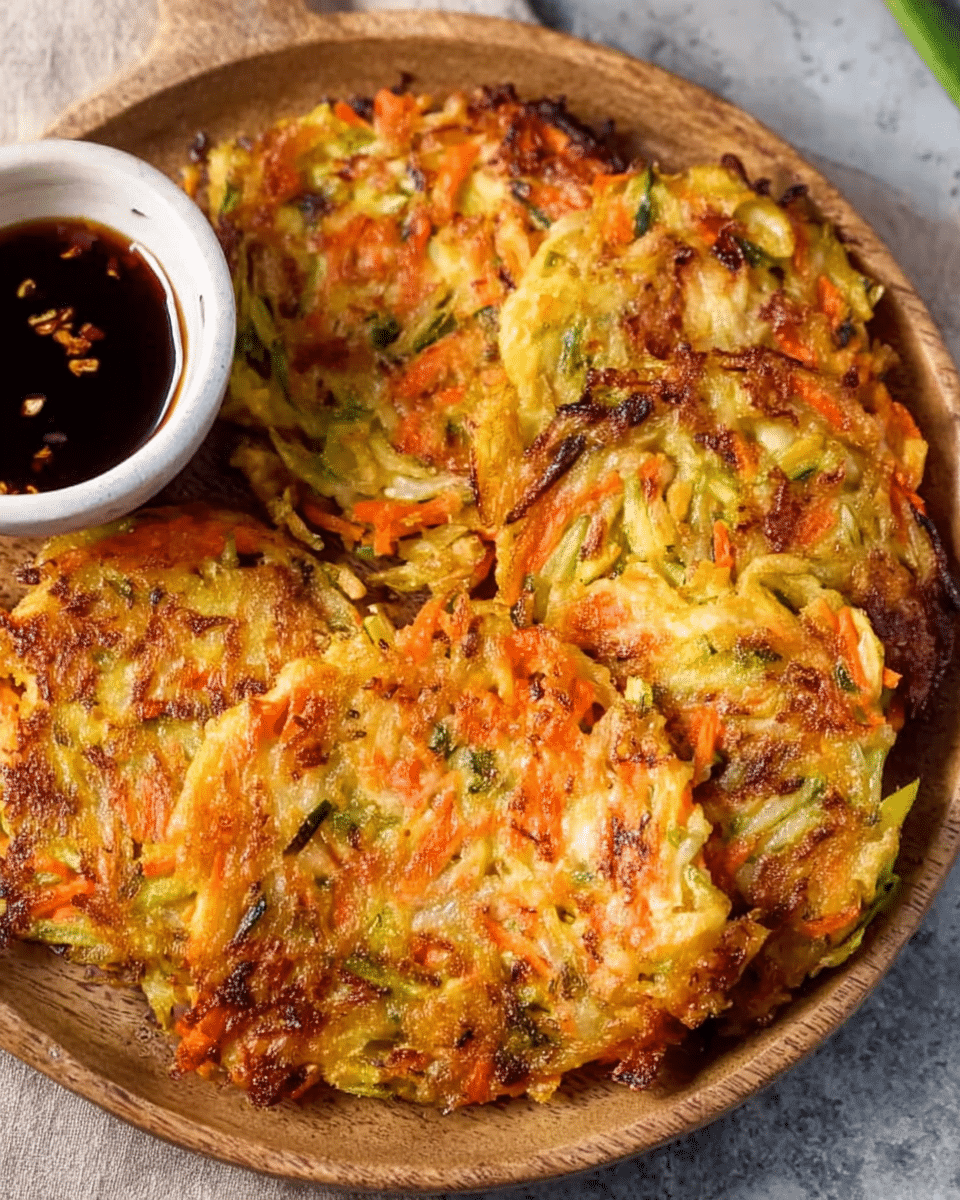These crispy and savory Korean vegetable pancakes, known as Yachajeon, are perfect for breakfast, dinner, or as a snack. Made with a simple batter and packed with fresh vegetables like carrots, onions, and cabbage, they are fried until golden brown, offering a delicious crispy exterior with a soft, flaky interior. Paired with a tangy dipping sauce, they are sure to be a hit!
Full Recipe:
Ingredients
-
For the Pancakes
-
1/2 cup all-purpose flour
-
1 tbsp corn flour
-
1/2 cup water
-
2-2 1/2 cups vegetables of choice (e.g., spring onions, carrots, cabbage, onions), sliced lengthwise
-
1-2 tbsp neutral cooking oil
-
-
For the Dipping Sauce
-
2 tbsp soy sauce
-
1 tbsp vinegar
-
Sesame seeds
-
Gochugaru (crushed red pepper flakes)
-
Directions
-
Make the Batter: In a bowl, whisk together the all-purpose flour, corn flour, and water until smooth. Stir in the vegetables sliced lengthwise.
-
Cook the Pancake: Heat oil in a non-stick skillet over medium heat. Spread the batter evenly in the pan, flattening gently with the back of a spatula.
-
Fry: Lower the heat and let the pancake cook evenly on both sides. Flip it halfway through, adding more oil if needed, until both sides are golden brown and the veggies are tender.
-
Prepare the Dipping Sauce: While the pancake is cooking, whisk together the soy sauce, vinegar, sesame seeds, and gochugaru in a bowl.
-
Serve: Once cooked, slice the pancake into bite-sized pieces and serve with the dipping sauce on the side.
Nutritional Facts (per serving)
-
Calories: 150
-
Protein: 3g
-
Fat: 7g
-
Saturated Fat: 1g
-
-
Carbohydrates: 22g
-
Fiber: 3g
-
Sugar: 4g
-
-
Sodium: 600mg
-
Potassium: 200mg
-
Cholesterol: 0mg
-
Calcium: 25mg
-
Iron: 1.5mg
-
Vitamin A: 1200 IU
-
Vitamin C: 6mg
The Simplicity of Yachajeon
Yachajeon is a straightforward dish that highlights the natural flavors of fresh vegetables. What makes this dish so appealing is its simplicity. The batter itself is made from just a few ingredients: all-purpose flour, corn flour, and water. This minimal ingredient list allows the vegetables to shine, showcasing their crispness and natural sweetness. Unlike many other pancake recipes that require complex ingredients or seasonings, Yachajeon delivers a satisfying taste with very few steps involved.
The vegetables used in the pancakes are sliced lengthwise, ensuring that they remain crunchy and provide a satisfying texture when fried. Common vegetables used include spring onions, carrots, cabbage, and onions, though you can easily adjust the mix based on what you have available. The variety of vegetables not only adds color and flavor to the dish but also enhances its nutritional value, making Yachajeon a healthy and balanced option.
The Perfect Texture: Crispy on the Outside, Flaky on the Inside
One of the key attributes of Yachajeon is its texture. When fried, the pancakes develop a golden-brown, crispy exterior that provides a satisfying crunch with every bite. The inside, on the other hand, remains soft and tender, allowing the vegetables to cook through without losing their bite. This contrast between the crispy outer layer and the soft, flaky interior is what makes these pancakes so enjoyable to eat.
The batter, made from flour and corn flour, helps create the perfect crispy texture. Corn flour, or cornstarch, is often used in Asian cooking to enhance the crispiness of fried dishes, and it plays a key role in giving Yachajeon its golden, crunchy finish. The batter is spread thinly over the vegetables, allowing them to fry evenly and absorb just the right amount of oil, ensuring that the pancakes don’t become greasy.
The Versatility of Yachajeon
Yachajeon is incredibly versatile, making it suitable for a variety of occasions and dietary preferences. This dish can easily be adapted to include whatever vegetables you have on hand. If you prefer a heartier version, you can even add some protein, such as tofu or tempeh, to make the pancakes more filling. The beauty of Yachajeon lies in its flexibility—whether you choose to keep it simple with just vegetables or add extra ingredients, it’s easy to customize the dish to suit your tastes.
Additionally, Yachajeon can be served in various ways. While the traditional method is to serve it as a side dish or snack, it can also function as the main course in a meal, especially if paired with a light soup or some rice. The pancakes are also great for meal prepping, as they can be made in advance and stored for later use. Whether enjoyed fresh from the skillet or reheated, Yachajeon remains a delicious and satisfying dish.
The Essential Dipping Sauce
The dipping sauce is a key component of Yachajeon, adding a burst of flavor that complements the savory pancakes. The simple combination of soy sauce, vinegar, sesame seeds, and gochugaru (crushed red pepper flakes) creates a balanced sauce that is tangy, slightly spicy, and umami-rich. The soy sauce provides a savory base, while the vinegar adds a tartness that cuts through the richness of the fried pancakes. The sesame seeds give a subtle nutty flavor, and the gochugaru adds a mild heat that enhances the overall taste.
This dipping sauce is easy to prepare and can be adjusted to suit your spice preferences. If you enjoy more heat, simply add more gochugaru or even a touch of chili oil. The beauty of the dipping sauce is that it’s not overpowering but complements the pancakes, allowing the fresh vegetable flavors to remain at the forefront.
Cultural Significance of Yachajeon in Korean Cuisine
In Korean cuisine, pancakes like Yachajeon are not just food; they are an important part of the culinary culture. Known as “jeon,” these savory pancakes are often made to celebrate special occasions, such as holidays and family gatherings. Yachajeon is a variation that highlights vegetables, making it a lighter alternative to some of the meatier versions of jeon. It is also a popular dish during Korean New Year celebrations, where different types of jeon are prepared and shared among family members.
While it is common to serve Yachajeon during special occasions, it’s also a practical and comforting dish that can be enjoyed any day of the week. Many Korean households make Yachajeon as a quick meal or snack, and it’s also commonly found in street food markets, where vendors fry fresh pancakes and serve them on the spot. Whether eaten at home or enjoyed while out and about, Yachajeon is a beloved dish that evokes feelings of warmth and comfort.
Health Benefits of Yachajeon
Despite being fried, Yachajeon can be a relatively healthy dish, especially when made with fresh vegetables. The vegetables provide essential vitamins, minerals, and fiber, contributing to a well-rounded and nutritious meal. Carrots are rich in vitamin A, which is important for eye health, while cabbage offers a good dose of vitamin C, which supports the immune system. Onions and spring onions add antioxidants and contribute to heart health.
The dish can also be made even healthier by adjusting the oil used for frying. Opting for healthier oils, such as olive oil or avocado oil, can help reduce the saturated fat content while still achieving the desired crispiness. Furthermore, the dipping sauce, made with soy sauce, vinegar, and sesame seeds, provides a flavorful yet light accompaniment that adds little to the overall calorie count.
Perfect for Any Meal or Occasion
Yachajeon’s versatility makes it ideal for any meal or occasion. For breakfast, these crispy vegetable pancakes can be enjoyed with a side of pickled vegetables or a simple soup. For lunch or dinner, Yachajeon pairs wonderfully with rice and a variety of side dishes, such as kimchi or stir-fried vegetables. It also makes an excellent snack, perfect for sharing with friends or family. The ability to serve Yachajeon as a main dish or an appetizer gives it a special place in Korean cuisine, making it suitable for any time of day.
The dish is also ideal for meal prepping, as the pancakes can be cooked in advance and stored in the refrigerator. When reheated, they maintain their crispy exterior and soft interior, making them a convenient option for busy days. The dipping sauce can be prepared ahead of time as well, making this dish an easy and flavorful choice for lunchboxes or quick dinners.
Conclusion
In conclusion, Korean Vegetable Pancakes (Yachajeon) offer a perfect combination of crispy, savory goodness and fresh vegetable flavors. These pancakes are incredibly versatile, making them suitable for breakfast, lunch, dinner, or as a snack. Whether you enjoy them as part of a larger meal or as a standalone dish, Yachajeon delivers satisfying flavors and textures that everyone will love. With a simple batter, fresh vegetables, and a tangy dipping sauce, this dish embodies the heart of Korean comfort food. Whether you are making it for yourself or sharing it with others, Yachajeon is sure to be a hit at the table, providing a delicious and wholesome way to enjoy vegetables.






